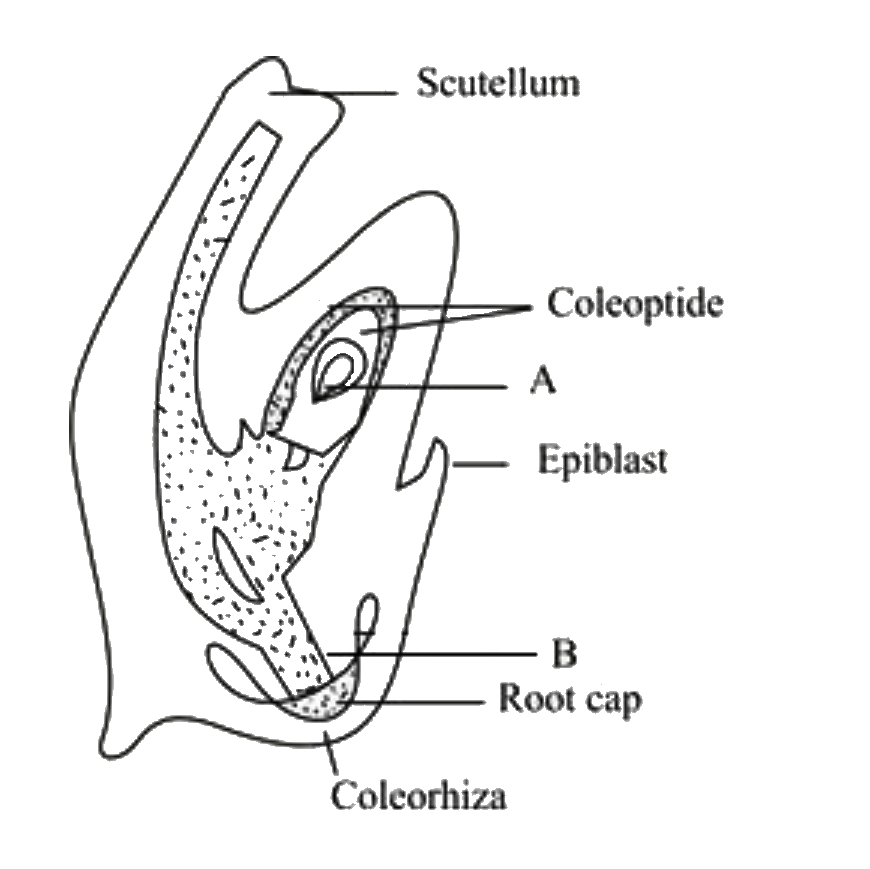Shoot apex and root apex
Step-by-Step Text Solution:
1. Definition of Shoot Apex:
- The shoot apex is the growing tip of a plant shoot. It is typically dome-shaped and located at the terminal end of the stem.
2. Structure of Shoot Apex:
- The shoot apex consists of several key components:
- Pseudepical Meristem: This is the region responsible for the growth of the shoot. It adds cells to the base of the shoot.
- Leaf Primordium: These are small structures that will develop into leaves.
- Quiescent Center: This is a region within the shoot apex that is not actively dividing. It is also referred to as the reserve meristem, where there is less synthesis of RNA and proteins.
- Meristematic Zone: This area is where active cell division occurs, contributing to the growth of the shoot.
3. Definition of Root Apex:
- The root apex is the growing tip of a plant root. It is generally cup-shaped and located at the sub-terminal end of the root.
4. Structure of Root Apex:
- The root apex has several important components:
- Root Cap: This structure protects the root apex as it grows through the soil.
- Root Apical Meristem: This is the region responsible for the growth of the root, adding cells both upwards and downwards.
- Quiescent Center: In the root apex, this region is distinguishable and acts as a reserve meristem, where some synthesis of RNA and proteins occurs.
- Central Cylinder: This is the core of the root where vascular tissues are located.
5. Theories Explaining the Structure:
- For the shoot apex, two theories explain its structure:
- Tunica-Corpus Theory
- Establishment Theory
- For the root apex, the structure is explained by:
- Histogen Theory
- The shoot apex is the growing tip of a plant shoot. It is typically dome-shaped and located at the terminal end of the stem.
- The shoot apex consists of several key components:
- Pseudepical Meristem: This is the region responsible for the growth of the shoot. It adds cells to the base of the shoot.
- Leaf Primordium: These are small structures that will develop into leaves.
- Quiescent Center: This is a region within the shoot apex that is not actively dividing. It is also referred to as the reserve meristem, where there is less synthesis of RNA and proteins.
- Meristematic Zone: This area is where active cell division occurs, contributing to the growth of the shoot.
- The root apex is the growing tip of a plant root. It is generally cup-shaped and located at the sub-terminal end of the root.
- The root apex has several important components:
- Root Cap: This structure protects the root apex as it grows through the soil.
- Root Apical Meristem: This is the region responsible for the growth of the root, adding cells both upwards and downwards.
- Quiescent Center: In the root apex, this region is distinguishable and acts as a reserve meristem, where some synthesis of RNA and proteins occurs.
- Central Cylinder: This is the core of the root where vascular tissues are located.
- For the shoot apex, two theories explain its structure:
- Tunica-Corpus Theory
- Establishment Theory
- For the root apex, the structure is explained by:
- Histogen Theory
Topper's Solved these Questions
- ANATOMY OF FLOWERING PLANTS Book:ICSEChapter:ANATOMY OF FLOWERING PLANTS Exercise:Ncert Exercises with Answers
Explore 12 Videos
- ANATOMY OF FLOWERING PLANTS - PLANT TISSUESBook:ICSEChapter:ANATOMY OF FLOWERING PLANTS - PLANT TISSUESExercise:REVIEW QUESTIONS (LONG ANSWER TYPE QUESTIONS)
Explore 20 Videos
Similar Questions
Knowledge Check
Assertion : The constantly dividing cells both at the root apex and the shoot apex, show the meristematic phase of growth.
Reason : The cells of this region are rich in protoplasm and are without nuclei.AIf both assertion and reason are true and reason is the correct explanation of assertionBIf both assertion and reason are true but reason is not the correct explanation of assertionCIf assertion is true but reason is falseDIf both assertion and reason are false
Quiescent centre is seen in :
(a) Floral axis
(b) Root apex
(c) Shoot apex
(d) Vegetative apex
View SolutionWhich phase of growth is represented by root apex & shoot apex?
View SolutionDefine meristematic tissue. Compare shoot and root apices with the help of diagrams.
View SolutionShoot apex forms lateral branches of stem, leaves and
(a) Is unidirectional in activity
(b) Is present just above youngest leaf primordia
(c ) Does not show plastochron periodicity
(d) Shows subterminal position
View SolutionWhich pair of substances are used to induce shoot formation and root formation respectively during organogenesis ?
View SolutionIn the L.S. of an embryo of grass, the labels A and B are:

(a) A-Shoot apex, B-Radicle
(b) A-Root cap, B-Radicle
(c) A-Shoot apex, B-Epiblast
(d) None of these
View SolutionThe apex of root is protected by the
View Solution

